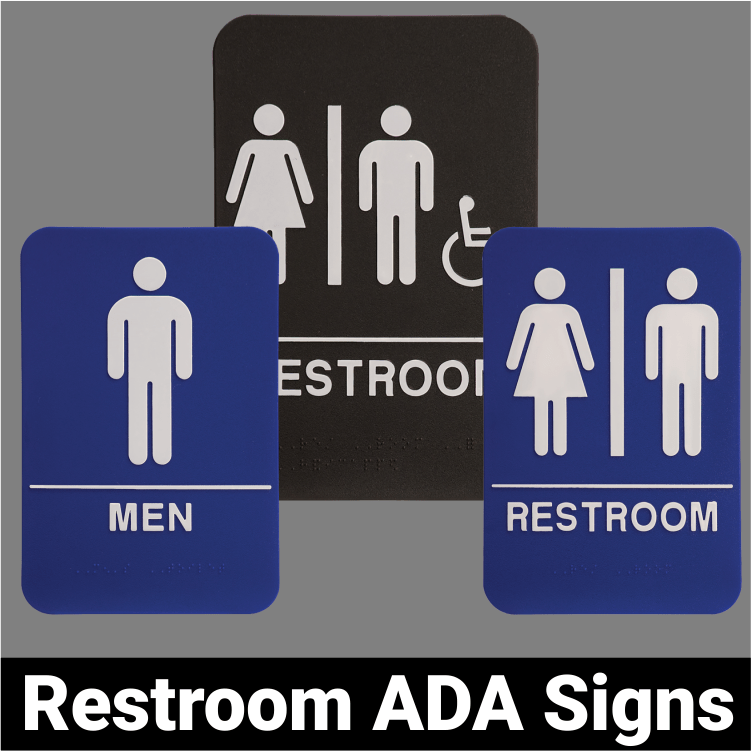The Impact of ADA Signs on Community Access
The Impact of ADA Signs on Community Access
Blog Article
Checking Out the Secret Features of ADA Signs for Enhanced Ease Of Access
In the world of accessibility, ADA indicators serve as quiet yet effective allies, making sure that spaces are navigable and inclusive for individuals with specials needs. By incorporating Braille and tactile components, these signs break barriers for the visually impaired, while high-contrast shade plans and readable font styles cater to diverse aesthetic requirements.
Significance of ADA Compliance
Ensuring conformity with the Americans with Disabilities Act (ADA) is vital for fostering inclusivity and equivalent accessibility in public rooms and work environments. The ADA, established in 1990, mandates that all public facilities, employers, and transport services suit individuals with specials needs, guaranteeing they take pleasure in the exact same rights and opportunities as others. Compliance with ADA requirements not only fulfills lawful responsibilities however also enhances an organization's track record by showing its dedication to diversity and inclusivity.
One of the vital aspects of ADA conformity is the implementation of accessible signage. ADA indicators are created to guarantee that people with handicaps can quickly browse with areas and buildings. These indicators must comply with specific guidelines concerning dimension, typeface, color comparison, and positioning to assure visibility and readability for all. Effectively implemented ADA signage helps remove barriers that individuals with impairments usually encounter, consequently advertising their freedom and self-confidence (ADA Signs).
Additionally, adhering to ADA guidelines can reduce the danger of legal repercussions and potential penalties. Organizations that stop working to adhere to ADA standards might deal with charges or lawsuits, which can be both damaging and economically troublesome to their public image. Therefore, ADA compliance is indispensable to promoting an equitable setting for everyone.
Braille and Tactile Aspects
The incorporation of Braille and responsive aspects right into ADA signage personifies the principles of availability and inclusivity. These attributes are important for individuals that are blind or visually damaged, allowing them to browse public areas with better freedom and confidence. Braille, a tactile writing system, is essential in giving composed details in a format that can be quickly regarded through touch. It is typically put under the corresponding text on signage to ensure that individuals can access the details without aesthetic assistance.
Responsive components expand past Braille and consist of elevated personalities and icons. These elements are made to be discernible by touch, allowing individuals to recognize area numbers, washrooms, departures, and other crucial areas. The ADA establishes details standards pertaining to the dimension, spacing, and placement of these responsive components to optimize readability and make certain uniformity across various settings.

High-Contrast Color Pattern
High-contrast color design play a pivotal role in boosting the visibility and readability important source of ADA signs for individuals with aesthetic impairments. These schemes are crucial as they make best use of the difference in light reflectance in between message and background, ensuring that indications are easily discernible, also from a range. The Americans her comment is here with Disabilities Act (ADA) mandates making use of certain color contrasts to suit those with limited vision, making it a crucial facet of compliance.
The efficacy of high-contrast colors lies in their capability to stand out in various illumination problems, including dimly lit atmospheres and locations with glow. Usually, dark message on a light background or light message on a dark background is utilized to attain optimum contrast. As an example, black text on a yellow or white background supplies a raw visual distinction that assists in fast acknowledgment and comprehension.

Legible Fonts and Text Size
When considering the style of ADA signage, the option of legible typefaces and suitable text size can not be overstated. These aspects are essential for making sure that indicators are available to individuals with visual impairments. The Americans with Disabilities Act (ADA) mandates that fonts have to be not italic and sans-serif, oblique, script, extremely attractive, or of uncommon form. These demands aid ensure that the message is conveniently legible from a distance which the characters are distinguishable to diverse target markets.
According to ADA guidelines, the minimum message elevation should be 5/8 inch, and it should enhance proportionally with watching distance. Uniformity in text size contributes to a cohesive aesthetic experience, aiding people in navigating settings effectively.
In addition, spacing in between letters and lines is important to legibility. Ample spacing avoids characters from appearing crowded, boosting readability. By adhering to these requirements, designers can considerably boost availability, ensuring that signage serves its desired function for all individuals, despite their visual abilities.
Reliable Positioning Techniques
Strategic placement of ADA signs is essential for making best use of accessibility and making certain conformity with lawful criteria. ADA guidelines stipulate that indicators ought to be mounted at a height in between 48 to 60 inches from the ground to ensure they are within the line of view for both standing and seated individuals.
In addition, indications must be placed surrounding to the lock side of doors to permit easy recognition prior to access. This placement aids individuals locate rooms and rooms without obstruction. In situations where there is no door, signs must be situated on the nearest adjacent wall. Uniformity in indication placement throughout a facility improves predictability, minimizing complication and improving overall user experience.

Conclusion
ADA indicators play an essential duty in advertising accessibility by incorporating attributes that resolve the demands of people with impairments. These aspects jointly foster an inclusive setting, highlighting the value of ADA compliance in ensuring equal accessibility for all.
In the world of availability, ADA indications serve as quiet yet powerful allies, guaranteeing that spaces are inclusive and accessible for people with disabilities. The ADA, established in 1990, mandates that all public centers, employers, and transport solutions accommodate individuals with specials needs, ensuring they enjoy the very same legal rights and opportunities as others. ADA Signs. ADA indicators are developed to ensure that people with specials needs can easily browse through structures and rooms. ADA standards stipulate that indicators ought to be placed at an elevation between 48 to 60 inches from the ground to guarantee they are within the line of sight for both standing and seated individuals.ADA indicators play an important role in promoting availability by incorporating features that address the needs of individuals with disabilities
Report this page